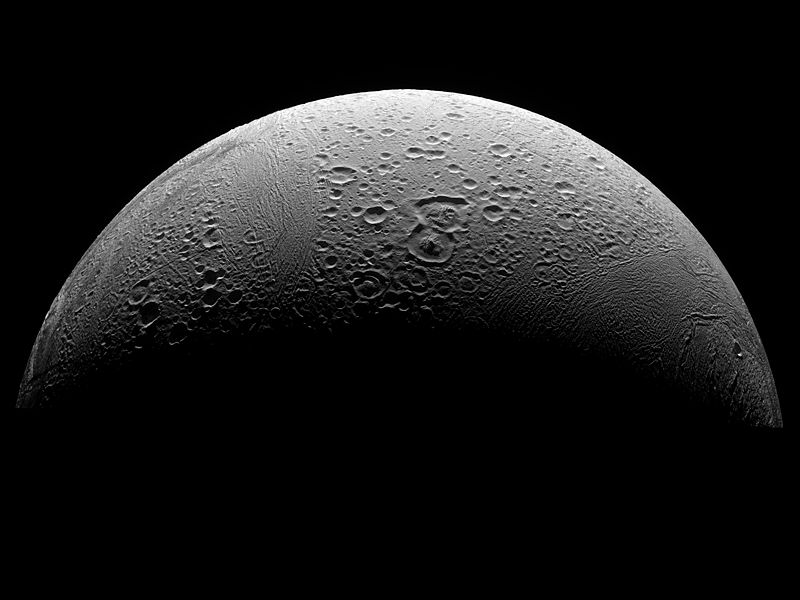An ocean of liquid water could well exist beneath the icy exterior of Enceladus, one of Saturn's moons, scientists have said this week. Two papers published in Nature, one by Frank Postberg at Heidelberg University and the other by Nicholas Schneider at the University of Colorado at Boulder, have sought to understand the origins of what's been dubbed "the biggest geyser in the solar system".  This refers to a plume of water-rich material which periodically shoots thousands of kilometres into the air from the surface of Enceladus and even contributes to one of Saturn's rings. The respective teams behind the work studied the plume for signs of sodium, their reasoning for doing so being that, just like on Earth, a large liquid ocean on Enceladus would inevitably dissolve salts from the moon's rocky core. Sodium, being easy to detect, would be an ideal way to confirm this. Schneider's Colorado-based team, looking from Earth with the Keck telescope, failed to spot any, but the German team, using an instrument aboard the Cassini spacecraft orbiting Saturn, were successful. What their analysis showed was that about 6% of the ice crystals that make up the plume contain significant amounts of salt. Together these results reveal a lot about the plume process taking place on Enceladus. If the geyser was the result of a hot pressurised ocean periodically erupting through the moon's surface then most of the icy particles would contain salt. Instead, argue the teams, the lack of salt favours instead some sort of evaporation and condensation process going on beneath the surface. What they envisage is a large salty ocean from which water evaporates, rather as it does on Earth when it forms clouds. This evaporated water then condenses to form mainly salt-free particles of freesh water, which are blown out when the geyser erupts. But what about the salty particles? These, say the scientists, reflect direct freezing of water from the ocean at points where the eruptions occur. This means that scientists now remain tantilised by a steaming, if not smoking gun on Enceladus as the possible next best bet for life elsewhere in the solar system because, on the basis of this evidence, it could well have all the ingredients for life - water, warmth, salts and organic chemicals. For now though we'll just have to speculate until Cassini comes back for a closer look that might reveal more about Old Faithful's big brother...
This refers to a plume of water-rich material which periodically shoots thousands of kilometres into the air from the surface of Enceladus and even contributes to one of Saturn's rings. The respective teams behind the work studied the plume for signs of sodium, their reasoning for doing so being that, just like on Earth, a large liquid ocean on Enceladus would inevitably dissolve salts from the moon's rocky core. Sodium, being easy to detect, would be an ideal way to confirm this. Schneider's Colorado-based team, looking from Earth with the Keck telescope, failed to spot any, but the German team, using an instrument aboard the Cassini spacecraft orbiting Saturn, were successful. What their analysis showed was that about 6% of the ice crystals that make up the plume contain significant amounts of salt. Together these results reveal a lot about the plume process taking place on Enceladus. If the geyser was the result of a hot pressurised ocean periodically erupting through the moon's surface then most of the icy particles would contain salt. Instead, argue the teams, the lack of salt favours instead some sort of evaporation and condensation process going on beneath the surface. What they envisage is a large salty ocean from which water evaporates, rather as it does on Earth when it forms clouds. This evaporated water then condenses to form mainly salt-free particles of freesh water, which are blown out when the geyser erupts. But what about the salty particles? These, say the scientists, reflect direct freezing of water from the ocean at points where the eruptions occur. This means that scientists now remain tantilised by a steaming, if not smoking gun on Enceladus as the possible next best bet for life elsewhere in the solar system because, on the basis of this evidence, it could well have all the ingredients for life - water, warmth, salts and organic chemicals. For now though we'll just have to speculate until Cassini comes back for a closer look that might reveal more about Old Faithful's big brother...
- Previous In-Flight Mind Reading
- Next Extraordinary snakes










Comments
Add a comment